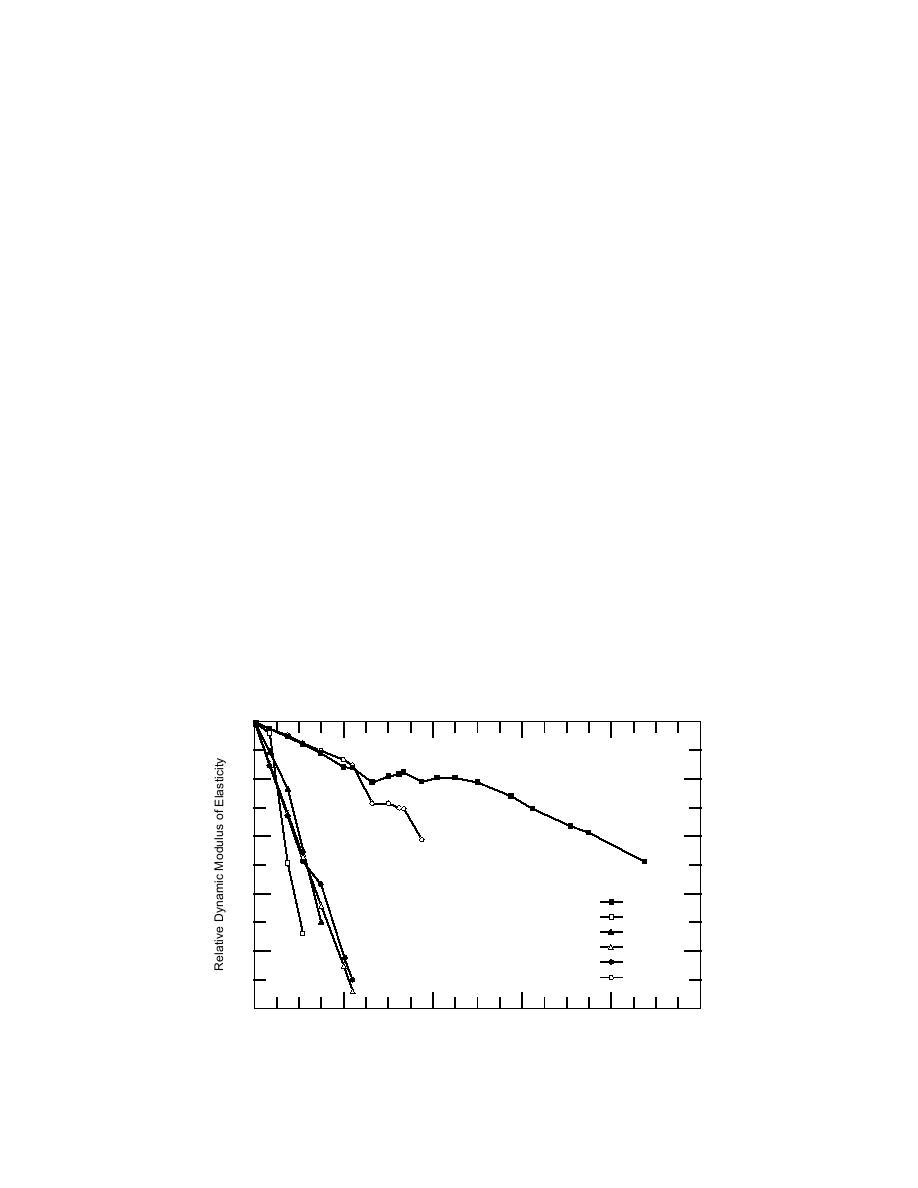
Rapid freezethaw test for concrete, ASTM C 666
original relative dynamic modulus of elasticity
At the time this project was initiated, there was
(RDME). Each specimen starts with an RDME of
no standard method designed specifically to
100, but this value decreases throughout the dura-
evaluate the freezethaw resistance of concrete
tion of the C 666 test as the internal structure of the
masonry units (Method C 1262 was not approved
specimen is damaged by the expansive forces of
by ASTM until late 1994). Before then, ASTM C
the water within its pores.
666 was often used for this purpose when need-
The conventional criterion used with structural
ed. The ASTM C 666 test method includes two
concrete is that specimens must retain at least 60%
different procedures: procedure A, Rapid Freez-
of the original RDME at the end of 300 freezethaw
ing and Thawing in Water, and procedure B,
cycles. If this criterion were used to evaluate the
Rapid Freezing in Air and Thawing in Water.
six sets of segmental retaining wall units, all
Both procedures are considered to be more severe
would be considered to fail. However, it is impor-
than field conditions, primarily due to the rapid
tant to note that the criterion used to evaluate per-
freezing rates in the test of roughly 5 to 15C (9 to
formance of structural concrete used in horizontal
27F)/hr as compared with common field rates of
highway applications would not be appropriate
less than 3C (5.4F)/hr. As with all laboratory
for use in evaluating concrete masonry units.
freezethaw test methods, the test is not intended
Freezethaw damage requires saturation of the
to simulate field conditions, but instead it pro-
concrete. Vertical, free-draining concrete masonry
duces an indication of relative freezethaw resis-
walls are rarely saturated. Therefore, their expo-
tance between different specimens.
sure conditions are much less severe than those of
Test specimens were saw-cut from units repre-
horizontal structural concrete, and the criteria for
senting each of the six different sets of segmental
evaluating satisfactory performance in the test
retaining wall units. Due to the size limitations of
method should not be consistent for the two mate-
the full-size units, the saw-cut test specimens
rials. While retaining walls may have a somewhat
were much smaller than required by C 666. The
greater saturation potential than most concrete
specimens were subjected to cyclical freezing and
masonry walls, their exposure is still much less
thawing using procedure B. Prior to testing and
severe than most highway concrete.
at regular intervals, the specimens were removed
The results of the tests cannot be compared to
from the test chamber to evaluate their condition
standard passfail criteria, since none exists for
using ASTM C 215, "Test Method for Fundamen-
concrete masonry units. However, the results
tal Transverse, Longitudinal, and Torsional Fre-
(shown in Figure 16) do provide useful informa-
quencies of Concrete Specimens." The results of
tion by demonstrating the relative performance
this method are expressed as a percentage of the
between the specimens.
100
80
60
40
SRW-A
SRW-G
SRW-H
SRW-I
20
SRW-J
SRW-K
0
0
40
80
120
160
200
Number of Freeze-Thaw Cycles
Figure 16. Results of the modified ASTM C 666 freezethaw test on segmental
retaining wall (SRW) units.
18



 Previous Page
Previous Page
